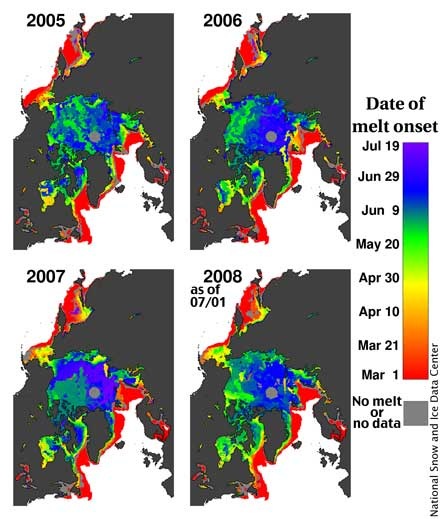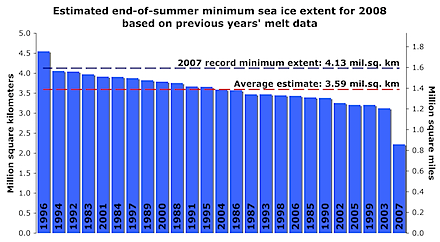 It’s getting hectic down here in the Waipara bunker: articles to write, truffles to harvest – stuff is piling up, not least in a multitude of tabs in my web browser, items set aside as possible subjects for posts here. So here’s one of my infrequent omnibus posts to give me some room to move around the web…
It’s getting hectic down here in the Waipara bunker: articles to write, truffles to harvest – stuff is piling up, not least in a multitude of tabs in my web browser, items set aside as possible subjects for posts here. So here’s one of my infrequent omnibus posts to give me some room to move around the web…
Tag: snow
Hole in the ice
 The National Snow & Ice Data Centre in the US is issuing regular (monthly, though they might have to become more frequent soon) updates on the progress of this year’s Arctic melt season. Today they released their report for June, and like their earlier reports (accessed from the drop down menu top right on the page), it includes a lot of very interesting reading. Here’s a highlight:
The National Snow & Ice Data Centre in the US is issuing regular (monthly, though they might have to become more frequent soon) updates on the progress of this year’s Arctic melt season. Today they released their report for June, and like their earlier reports (accessed from the drop down menu top right on the page), it includes a lot of very interesting reading. Here’s a highlight:
June sea ice extents in 2008 and 2007 are essentially identical, and near the lowest values for June ever recorded by satellite for the Arctic.
They note that the spatial pattern of melt this year is very different to last year, with much less melting in the Chuckchi Sea (top left on the pic at top – click for a bigger version), and much more to the north of Greenland and the Canadian archipelago. But the big news is that this year’s melt season started much earlier than usual. Take a look at this graphic:
The blue bits show the areas that start melting latest. 2007 was close to the long term average in that respect, and the difference with this year is striking:
This year, sea ice in the Beaufort Sea began to melt on average 15 days earlier than normal, and 15 days earlier than last year. Surface melt in the Chukchi and East Siberian seas was 6 days earlier than normal, and 14 days earlier than in 2007. In the central Arctic Ocean, melt began around June 9th, which was 12 days earlier than normal and 9 days earlier than the year before.
Even the areas where the ice still looks pretty solid (north of Siberia) started melting weeks ahead of normal. The next month is going to be extremely interesting. The odds are tipping my way again…
Note: my new favourite site for monitoring the current sea ice area is the University of Bremen’s imagery. I don’t mean to be disloyal to Cryosphere Today, which remains essential, but Bremen’s images are higher resolution, and to my eye make what’s going on easier to follow. If we could just get some of CT’s features at Bremen, and vice versa… 😉
[This post updated July 4 to reflect amended NSIDC graphic and text (see comments). Doesn’t look as bad as it did – but that’s not much cause for comfort.]
Sugar coated iceberg
 Prognostications on the fate of the Arctic sea ice this boreal summer are coming in thick and fast. The National Snow and Ice Data Centre in the US has updated its summer news page with the latest data and some projections of what might happen:
Prognostications on the fate of the Arctic sea ice this boreal summer are coming in thick and fast. The National Snow and Ice Data Centre in the US has updated its summer news page with the latest data and some projections of what might happen:
Spring has arrived in the Arctic. After peaking at 15.21 million square kilometers (5.87 million square miles) in the second week of March, Arctic sea ice extent has declined through the month of April. April extent has not fallen below the lowest April extent on record, but it is still below the long-term average. Taken together, an assessment of the available evidence, detailed below, points to another extreme September sea ice minimum. Could the North Pole be ice free this melt season? Given that this region is currently covered with first-year ice, that seems quite possible.
Most striking are the estimates of this summer’s likely minimum based on the melting rates observed over the last 25 years.

“To avoid beating the September 2007 record low, more than 50% of this year’s first-year ice would have to survive; this has only happened once in the last 25 years, in 1996.”
Meanwhile, Andy Revkin at the New York Times has been asking sea ice researchers for their views. You can read their replies in the comments to his post. A number of well-known names are backing a new record, including BIll Chapman, the researcher responsible for the excellent Cryosphere Today site (I want to get an iPhone so that I can try out the special graphics CT provides), who writes:
The two wild cards remaining would be (1) how thick is this first-year ice and (2) will it be warm enough to melt the first-year ice this summer? Since temperatures over the central Arctic were normal to above normal this past winter and spring, I don’t think the thickness will be too great. The key will be June temperatures and cloud cover in the central Arctic. Given relatively clear conditions and an early to average start to the melt of the central Arctic, the albedo will lower and the process will be in motion to easily melt that first year ice. In fact, the only thing that could prevent a record would be a colder than average summer – especially early summer. Given recent history and our penchant for burning fossil fuels, I’d consider this somewhat unlikely.
I say the odds favor a new NH record minimum – put my money there.
My money’s already there… Good to know I’m backing the form horse, even if I would rather lose.
“The Arctic ice is back to normal.” Yeah, right. #2
This latest New Scientist video accompanies a news item headlined “North Pole could be ice free in 2008“, and shows multi-year ice moving out of the Arctic over winter.
“The set-up for this summer is disturbing,” says Mark Serreze, of the US National Snow and Ice Data Center (NSIDC). A number of factors have this year led to most of the Arctic ice being thin and vulnerable as it enters its summer melting season.”
Also of interest in the video: look at the large cracks in the thicker ice north of Canada.
“The Arctic ice is back to normal.” Yeah, right.
This New Scientist video includes some rather spectacular images of a rapidly draining meltwater lake on the surface of the Greenland ice sheet. The three kilometre wide lake drained down through 1 km of ice in an hour and a half, at a rate similar to that of the water flowing over the Niagara Falls. Full story here, and more detail from NASA here. Meanwhile, RealClimate covers the factors driving the acceleration of Greenland’s outlet glaciers, the principle mechanism for getting large volumes of ice into the ocean. There’s some interesting stuff in the comments, too, particularly from a scientist (Tad Pfeiffer) working on establishing an upper limit to the contribution to global sea level rise likely from Greenland’s glaciers. Nature also has a very nice overview article on the state of research on the GIS, but unfortunately it’s hidden away behind a paywall.
Offshore in the high Canadian Arctic, Canadian Rangers have discovered large cracks are appearing in the Ward Hunt ice shelf, a large chunk of very old and thick ice on the northern coast of Ellesmere Island. The Arctic sea ice has now begun its spring melt back, and the National Snow & Ice Data Centre has posted a page to monitor this summer’s events. The time series graph of ice extent (here) compares current ice to last year’s record and the 79-2000 average. You can monitor ice area (a slightly different metric) at Cryosphere Today (here).
Down South, more results from the Andrill Project were presented at last week’s European Geophysical Union conference. Researchers now have a climate history for the continent stretching back 17 million years, and there are plans to drill a new core (starting in 2012) to take that back to 40 million years, when the continent started iceing up. Grab the Nature article before it disappears behind a paywall.
 This is the Tasman Glacier, near Mt Cook, from the lookout on the lateral moraine a couple of months ago (click for a larger version: pic ©GR). New fieldwork shows that the lake is now 7 km long, 2 km wide and – amazingly – 245 m deep. The results confirm that the presence of the lake effectively dooms the glacier to disappear – within 20 years, according to the research team from Massey University. Herald story here.
This is the Tasman Glacier, near Mt Cook, from the lookout on the lateral moraine a couple of months ago (click for a larger version: pic ©GR). New fieldwork shows that the lake is now 7 km long, 2 km wide and – amazingly – 245 m deep. The results confirm that the presence of the lake effectively dooms the glacier to disappear – within 20 years, according to the research team from Massey University. Herald story here.
